Seven Questions Over Breakfast with Marisabina Russo
 July 25th, 2012 by jules
July 25th, 2012 by jules
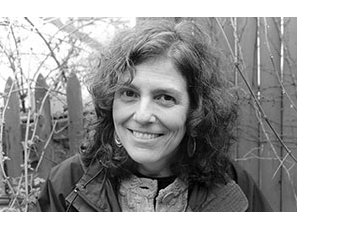 This morning I’m having breakfast with author/illustrator Marisabina Russo. To be precise, we’re having a glass of orange juice, some whole wheat English muffins with honey, and some café lattes. “My husband makes French toast on the weekends,” Marisabina told me. “In the summer, I buy granola at the local farmers market and fresh blueberries. That’s really my favorite.” (Note to self: Though it all sounds good, next time interview her on a weekend for some of those pancakes. I’ll bring the syrup.)
This morning I’m having breakfast with author/illustrator Marisabina Russo. To be precise, we’re having a glass of orange juice, some whole wheat English muffins with honey, and some café lattes. “My husband makes French toast on the weekends,” Marisabina told me. “In the summer, I buy granola at the local farmers market and fresh blueberries. That’s really my favorite.” (Note to self: Though it all sounds good, next time interview her on a weekend for some of those pancakes. I’ll bring the syrup.)
Marisabina grew up in Queens and knew from a young age that she loved art and wanted to make a career of it. At the very bottom of this post, she shares the comprehensive list of books she’s both written and illustrated in her career, including two YA novels.
I Will Come Back for You: A Family in Hiding During World War II, one of her latest picture books (released by Schwartz & Wade), has been named a Bank Street Best Book for 2012, as well as a Sydney Taylor Award Notable Book. The book, based on her mother’s own experiences, tells the story of a Jewish girl living in Rome with her family until Italy aligns itself with Nazi Germany, making life dangerous for Jews.
Russo works in gouache, bringing young readers bright, crisp, and expressive paintings. Her books are detailed yet never too busy, and the two bunny books you see featured below are both funny and emotionally-resonating — that is, for anyone who either feels or has felt like a misfit in the classroom or who simply doesn’t want to go to bed. (I fall into both categories, and I’m sure many others do.)
Plus, Russo can communicate a whole flippin’ lot through her bunnies’ ears alone. It’s a delight to see.
Let’s get right to the Q & A so that we can all see more art. I thank Marisabina for visiting.
Jules: Are you an illustrator or author/illustrator?
Marisabina: Author/Illustrator.
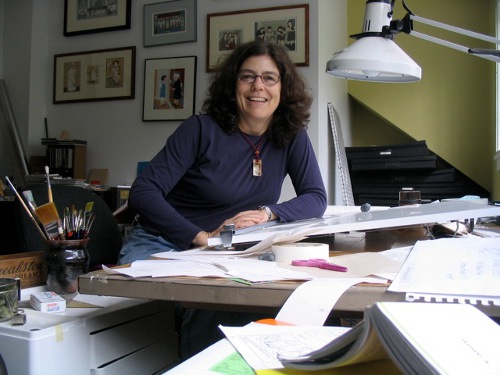
Jules: Can you list your books-to-date?

Marisabina: Well, I’ve written and illustrated 25 books (23 picture books and two YA novels), plus illustrated eight books by other authors, including Kevin Henkes, Nikki Giovanni, and Stephanie Calmenson. The books I’ve written and illustrated include:
- The Line Up Book
- The Big Brown Box
- Always Remember Me: How One Family Survived World War II
- The Bunnies Are Not in Their Beds
- A Very Big Bunny
- I Will Come Back for You: A Family in Hiding During World War II
- Peter is Just a Baby
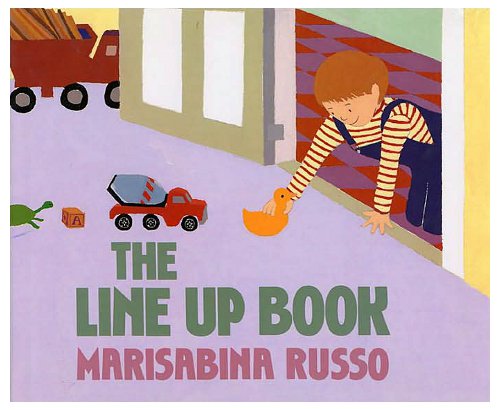
Jules: What is your usual medium, or––if you use a variety—your preferred one?
Marisabina: Gouache on Arches cold pressed watercolor paper.
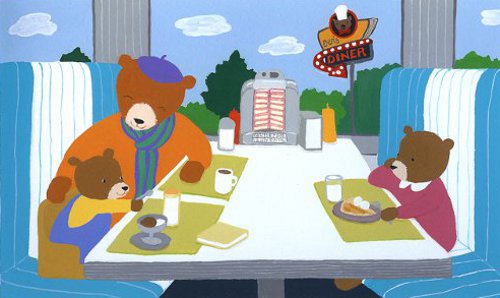

It’s much more dramatic than ‘too bad’ and always gets attention.”

The New York Times covered this one here in January of this year,
and see also this post from Marisabina at Eerdman’s blog
Jules: If you have illustrated for various age ranges (such as, both picture books and early reader books OR, say, picture books and chapter books), can you briefly discuss the differences, if any, in illustrating for one age group to another?
Marisabina: My first books were picture books for younger children, and I developed a very flat, clean, graphic style, often called “naïf” by reviewers. I think you can tell how much I love color.
In college, I did a lot of silkscreening and acrylic painting. After a while, I found the flat quality of the screen prints sneaking into my paintings. Just before graduation, one of my professors gave me a box of gouache paints and told me to try them. I was soon hooked!
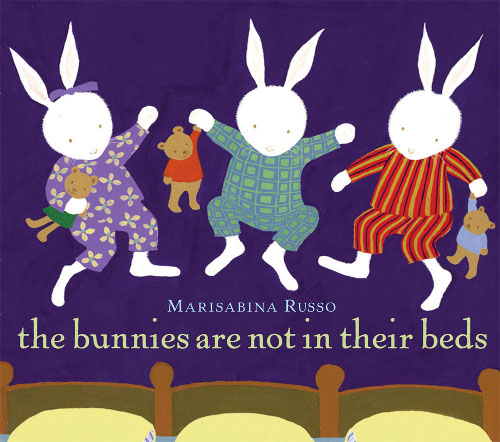
(Schwartz & Wade, 2007)
When I worked on Always Remember Me, which is a book about the Holocaust for older children, it was clear that I had to use a different technique. The story is told through old family photographs. Not wanting to literally recreate the photos, I experimented a lot. Gouache is a very versatile medium. I was able to water it down, use dryer brushes, etc. to create the look of old photos. But I didn’t want replicas, so I decided to use one color in each sepia or black & white photo painting. It made the pictures come to life for me. The hardest part was the two page spread of documents that the family needed to collect if they wanted to emigrate. I had been thinking we could use a collage of actual documents, but Anne Schwartz, my editor, said, “No, I want you to paint them.”


I painted a lot of full-color pictures like this.”
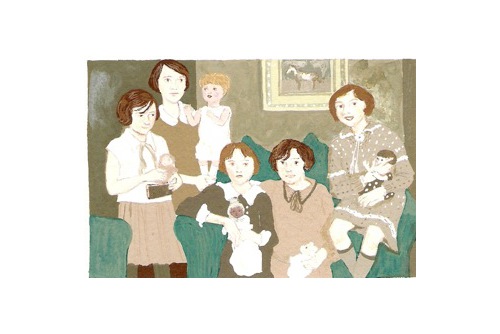
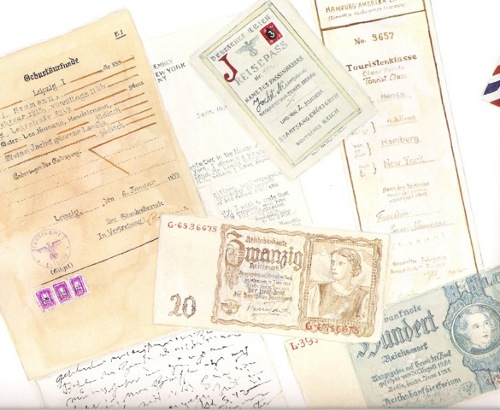
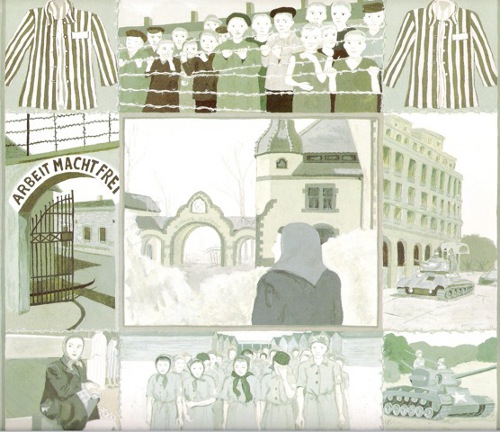
Working on that book was very rewarding but also emotionally draining. I was happy to do The Bunnies Are Not in Their Beds next [pictured above] with mischievous bunnies and lots of bright color.
My most recent book for Anne is I Will Come Back for You, again dealing with my family’s history during World War II. I spent some time in Italy to research the pictures and get a feeling for the light and color of the Marche region.

I had never seen the places where my mother and brothers were in hiding during the war. Luckily, my mother wrote a lot of her life story before she died, so I had plenty of information to guide me from village to village. It was another very emotional journey for me.
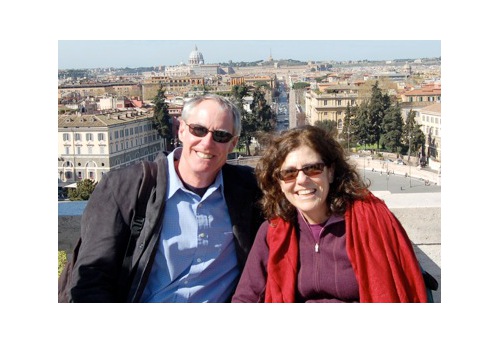
Jules: Where are your stompin’ grounds?
Marisabina: I live in the Hudson Valley, about an hour north of New York City.
A Family in Hiding During World War II (Schwartz & Wade, 2011)
(Click each image to enlarge)
Jules: Can you briefly tell me about your road to publication?
Marisabina: Early on, I pounded the Manhattan pavement with my portfolio, looking for freelance illustration work. I was very shy, so making phone calls to set up appointments with art directors was torture! But I did it. I got a lot of magazine work and then started selling spots and covers to The New Yorker. I did a lot of pen and ink spot drawings for them in the ’70s and ’80s:


I illustrated three cookbooks, including Marcella Hazan’s second one.

Things were going pretty well, but I had always dreamed of doing picture books. After I had my third child, I took a break from freelancing, but then fate intervened. A new friend, Murray Tinkelman, saw my art and insisted I meet Susan Hirschman at Greenwillow Books. She looked at my portfolio and encouraged me to write my own story. She even gave me a couple of blank dummies to take home. I wrote The Line Up Book, my first published picture book, and then went on to make many more books for Greenwillow. It was a wonderful environment for a new author, very much like family. Susan is retired now, but we are still close.
Jules: Can you please point readers to your web site and/or blog?
Marisabina: My website is www.marisabinarusso.com.
I’ve also got a Facebook page: www.facebook.com/marisabinarusso.

Jules: If you do school visits, tell me what they’re like.
Marisabina: I don’t do as many as I used to. My favorite grade is first. They really get my sense of humor. I tell them stories from my childhood, show them all the steps I use to create a book from idea, through writing, dummies, paintings, and then even talk a little about the printing process. (I was lucky enough to go to Hong Kong once with my art director at Greenwillow, Ava Weiss, and see one of my books roll off the presses.) I always end my presentations by drawing a large picture for the children using their suggestions. The classes get to keep the drawings and many teachers use them as jump off points for writing projects.
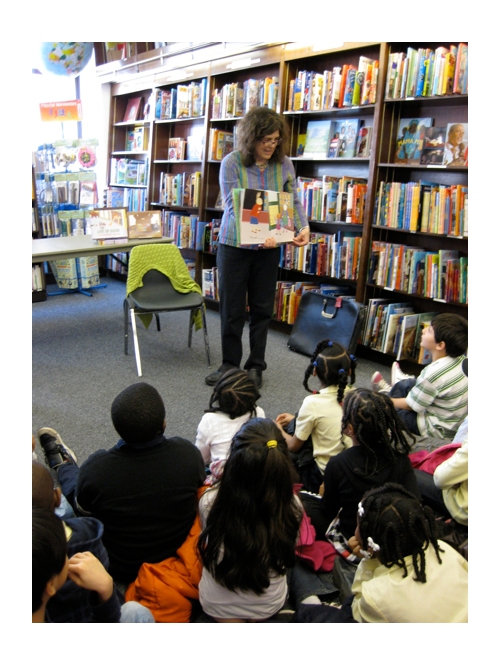
What I love is how the children keep getting closer and closer to me as the presentation goes on until they’re almost sitting on my lap.
I have also done workshops with older children on memoir-writing and illustrating. They’ll interview someone in their family and go from there.
Jules: If you teach illustration, can you tell me how that influences your work as an illustrator?
Marisabina: I don’t teach, but a few months ago I talked to an illustration class at Pratt, taught by Pat Cummings. Really great to see what the students are up to.
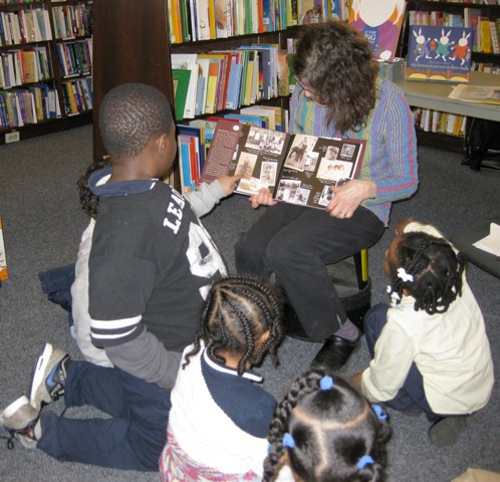
to a class at The Bank Street Bookstore
Jules: Any new titles/projects you might be working on now that you can tell me about?
Marisabina: I have a few new stories in the works. I’ve also embarked on a graphic novel for adults. It is a long way from being finished. I consider it my passion project. It has me in its grips and won’t let go! An editor has given me some great feedback that I am using to shape the narrative. I love the challenge. Really forces me out of my comfort zone. That’s always a good thing.
 Okay, the lattes are on the table, and it’s time to get a bit more detailed with seven questions over breakfast. I thank Marisabina again for visiting 7-Imp.
Okay, the lattes are on the table, and it’s time to get a bit more detailed with seven questions over breakfast. I thank Marisabina again for visiting 7-Imp.
1. Jules: What exactly is your process when you are illustrating a book? You can start wherever you’d like when answering: getting initial ideas, starting to illustrate, or even what it’s like under deadline, etc. Do you outline a great deal of the book before you illustrate or just let your muse lead you on and see where you end up?
Marisabina: I almost always start with the story. I write and revise and re-write a picture book manuscript many times before I even think about the illustrations. There is only one book I ever wrote that I don’t remember re-writing at all – Waiting for Hannah. I actually hid it under a pile of papers, thinking it wasn’t really a picture book and then one day decided to send it to Susan. She immediately accepted it. And it went on to be a Horn Book Fanfare book.
It is the entire wrap-around cover, sans type.”
(Click to enlarge)
There are exceptions to my “story first” rule, however. For example, Always Remember Me: How One Family Survived World War II: While I knew the story I wanted tell (it was a family story I grew up with) and I had the photos that inspired me, it still took almost two years to figure out how to pull it all together. I worked on both the words and pictures at the same time. It was so different from my previous books. (It possessed me the way the graphic novel does now.)
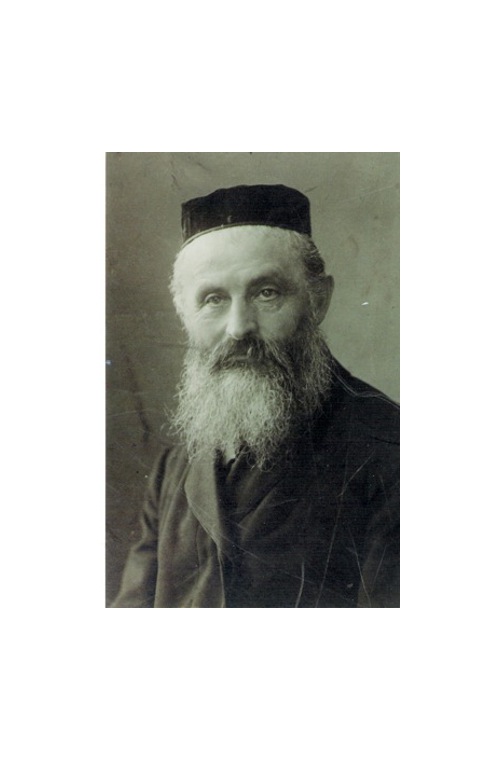

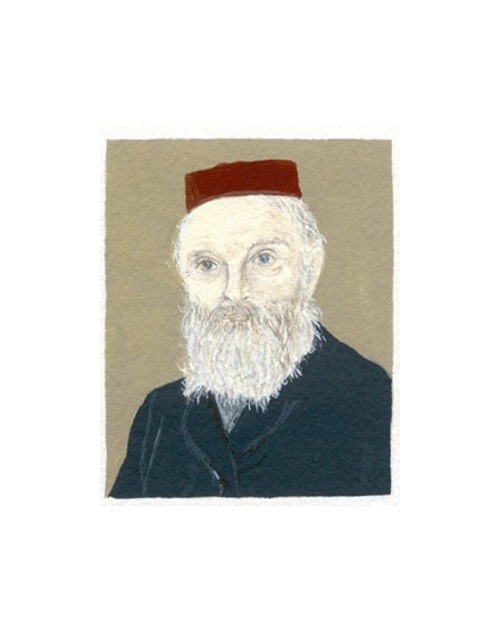


First image: Sabina in baby carriage; Second: Anny, Emmy, and Sabina
I was very lucky when Anne Schwartz saw my dummy and immediately understood and embraced the project. Another time I painted a very large bunny head for an “exquisite corpse” project for my editors at Schwartz & Wade. (They grouped three illustrators together to create three figures.) Lee Wade loved my bunny head and bugged me for months to write a story about a big bunny. That turned into the aptly-titled A Very Big Bunny.
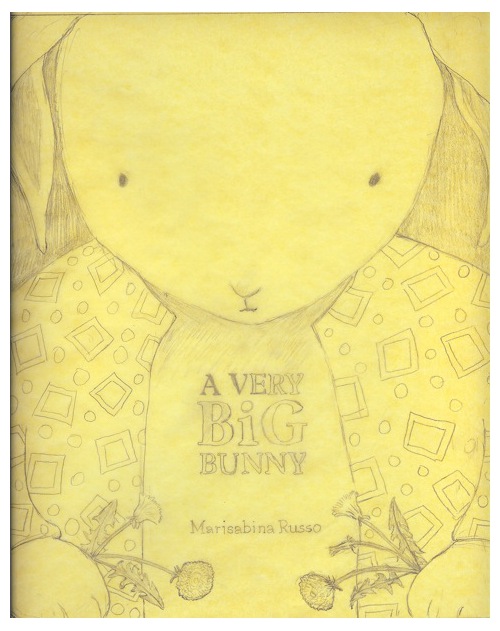


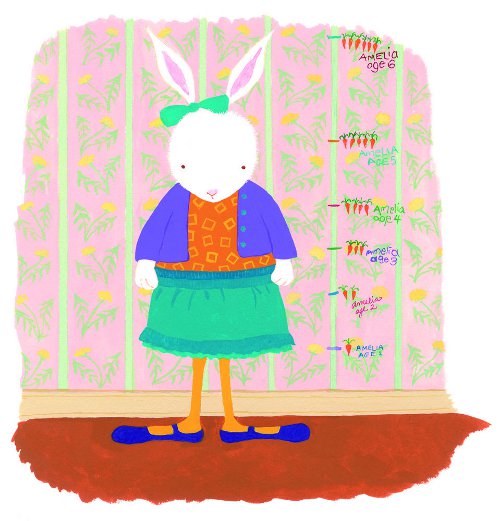
(Click to enlarge)
(Click to enlarge)
‘What a pip-squeak,’ whispered Lavinia. ‘What a peanut,’ whispered Justine.
‘What a shrimp,’ whispered Daphne.”
(Click to enlarge)
(Click to enlarge)
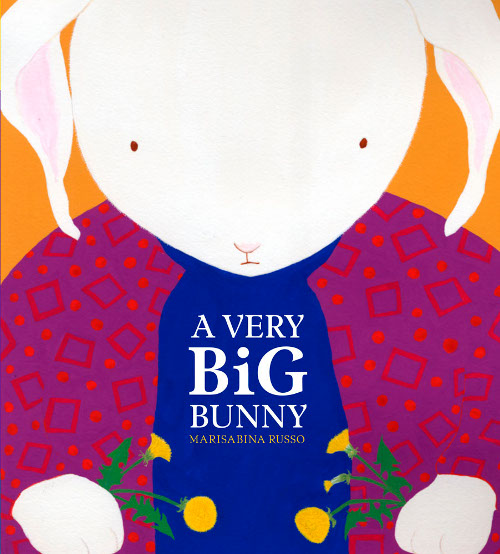
I do a lot of sketches and thumbnails before I actually make the dummy. As I move through the dummy, I start to see how the words and page turns will work. It’s like a dance, and sometimes I find places to prune the text. Dummying is probably the most challenging part of making a book (for me) and takes great focus and concentration. No music, no telephone, no plaintive dog begging to go out, please!
2. Jules: Describe your studio or usual work space.
Marisabina: I have a studio in my house with high ceilings and north light. It’s not as big as I want, but it works. For years I let my sons use it for their bedroom, because I felt guilty that they were squeezed into a tiny bedroom. So, I got the little room where only my dog and I could fit! As the old joke goes, you had to step outside to change your mind.

(Their names will be recognizable to anyone who has read those books.
Left to right: Hannah, Me, Ben, and Sam.)”
Soon as those boys were off to college, I reclaimed my studio. It is still crowded. I’ve got too much art to fit in my flat files, too many books, a bunch of craft projects and, of course, another dog who likes to hang out with me.

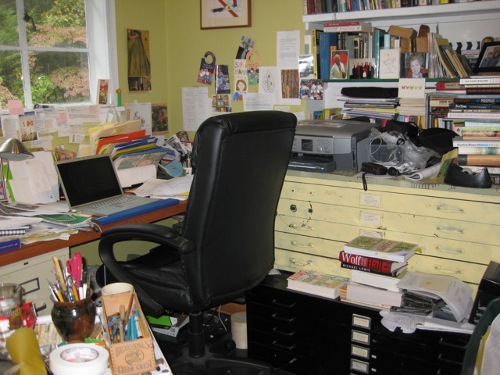


3. Jules: As a book-lover, it interests me: What books or authors and/or illustrators influenced you as an early reader?
Marisabina: My mother was a single, working mother, who had a thick German accent that kind of embarrassed her. She never read aloud to me. But I clearly remember a number of books that had a profound effect on me.
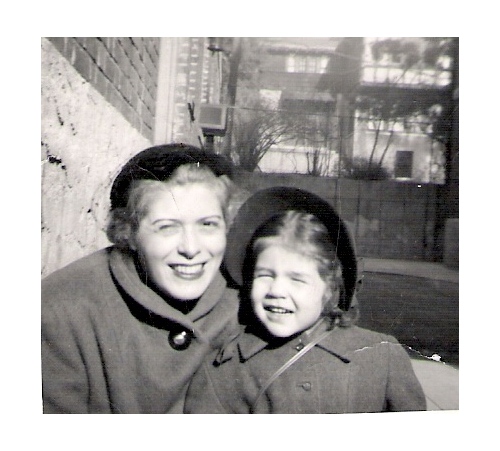
My brothers were 12 and 13 years older than I was, and they had books that were too hard for me to read but mesmerized me because of the illustrations: Hans Brinker, or The Silver Skates; Toby Tyler; and a book in Italian of traditional fairy tales that had the most magical pictures of all.
My aunt gave me Slovenly Peter, a translation of German cautionary tales with dark, menacing illustrations that fascinated and terrified me in equal measure.
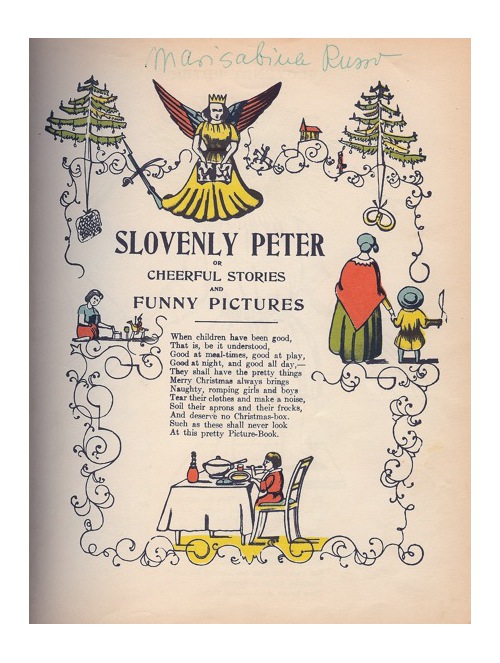
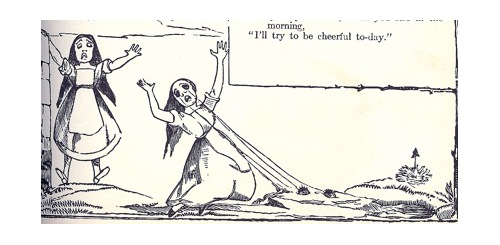
Detail from the story entitled ‘The Cry Baby'” …
Then I got the book based on the film The Red Balloon. As a child, I never saw the film, but I adored the book with its photographs of a lonely little boy in Paris. I often felt lonely and I also had a single mother, something I never saw in other books. And one of my brothers lived in Paris.
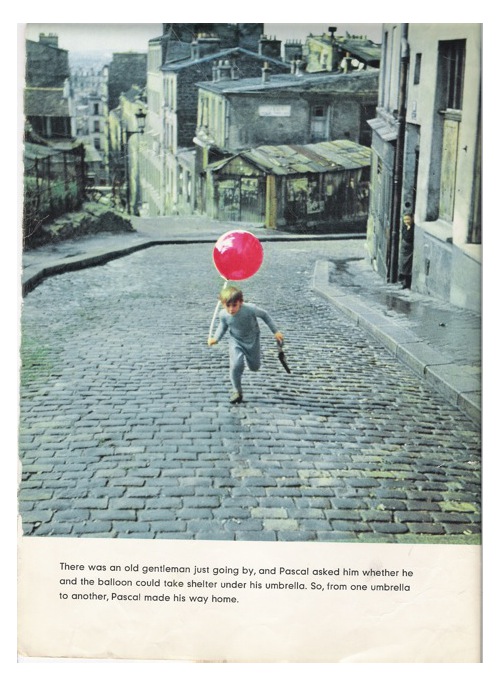
Finally (is this answer too long?), when I was older, my favorite book was by Rumer Godden — The Fairy Doll. Oh, how I loved that book. What a thrill it was for me when I met Ms. Godden one day in the Greenwillow offices.
[Pictured below is the cover of a September-2012 release of the book from Macmillan.]
4. Jules: If you could have three (living) authors or illustrators—whom you have not yet met—over for coffee or a glass of rich, red wine, whom would you choose?
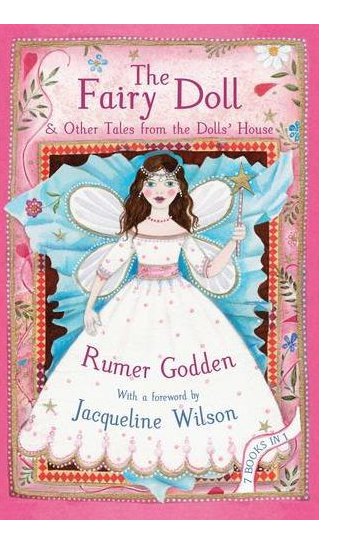 Marisabina: This is a very hard question. I’ve met and know many of my favorites. Only three? Okay – Maira Kalman, Molly Bang, and Marc Simont.
Marisabina: This is a very hard question. I’ve met and know many of my favorites. Only three? Okay – Maira Kalman, Molly Bang, and Marc Simont.
I also admire Jean Jacques Sempé, but I’m not sure he does children’s books? I would be thrilled to meet him, too.
5. Jules: What is currently in rotation on your iPod or loaded in your CD player? Do you listen to music while you create books?
Marisabina: I only listen to music while I’m painting. Sometimes, when I’m under deadline pressure, I will start the day with the same song every morning to pump myself up. It’s like I’m still in high school, playing a Motown record loud enough to annoy my mother.
I love jazz, especially stuff from the 1950s and ’60s, like Art Blakey, Horace Silver, Thelonius Monk, and also contemporary people like Dave Holland and Dave Douglas — whom I am lucky enough to call a friend. He kindly let me use some of his music in my book trailer for I Will Come Back for You.
And, speaking of deadlines, sometimes I stream a jazz station from the West Coast. It always makes me feel like I have more hours in the day.
 6. Jules: What’s one thing that most people don’t know about you?
6. Jules: What’s one thing that most people don’t know about you?
Marisabina: I’m a certified scuba diver.
7. 7-Imp: Is there something you wish interviewers would ask you — but never do? Feel free to ask and respond here.
Marisabina: Who was the first artist to inspire you?
My brother, Piero. He was a brilliant poet, painter, and underground filmmaker. He took me to The Louvre when I was a child, sent me books and records from Europe, pretty much opened my eyes to the possibilities at a very young age. Every envelope that arrived from him was a work of art. His paintings and assemblages hung all over our apartment when I was growing up.
[Pictured above right is Marisabina at age eight with her parakeet, Buttons.]

Jules: What is your favorite word?
Marisabina: It is impossible to choose just one. I like the words on paint tubes: “alzarin crimson,” “indigo,” “vermillion,” “cadmium yellow.”
Jules: What is your least favorite word?
Marisabina: Hands down, “moist.” Don’t know what it is, but the sound of that word makes my skin crawl. And forget “moist towelette.”
Jules: What turns you on creatively, spiritually or emotionally?
Marisabina: Hand-made things. Old photographs. The light, color, fish, and coral you find under the sea. People who are curious. Paintings and the Jazz collages of Matisse. Soundsuits by Nick Cave. The work of Saul Steinberg. I could go on and on.
Jules: What turns you off?
Marisabina: People who are set in their old cranky ways.
7-Imp: What is your favorite curse word? (optional)
Marisabina: My mother was from Germany but lived from ages 18 to 33 in Italy before coming to the U.S. She cursed in Italian, and I remember picking up my first curse from her, “Porca miseria!” or the elegant English translation, “Miserable swine!” Doesn’t sound like a curse, but she assured me it was the first time I blurted it out.
Jules: What sound or noise do you love?
Marisabina: My grandson’s laughter.
Jules: What sound or noise do you hate?
Marisabina: People talking on their cell phones on the train or bus or anywhere.
Jules: What profession other than your own would you like to attempt?
Marisabina: Maybe a playwright or a set designer? But another dream is to be a lounge singer. If only I could sing!
Jules: What profession would you not like to do?
Marisabina: Accountant.
Jules: If Heaven exists, what would you like to hear God say when you arrive at the Pearly Gates?
Marisabina: “You don’t ever have to wear shoes again.”
Photo credit for opening image of Marisabina: Gerard Malanga.
All other artwork and images used with permission of Marisabina Russo.
The spiffy and slightly sinister gentleman introducing the Pivot Questionnaire is Alfred, © 2009 Matt Phelan.
Marisabina’s Comprehensive List of Children’s Books:
Written & illustrated:
THE LINE UP BOOK, Greenwillow 1986.
WHY DO GROWN-UPS HAVE ALL THE FUN?, Greenwillow 1987.
ONLY SIX MORE DAYS, Greenwillow 1988.
WAITING FOR HANNAH, Greenwillow 1989.
WHERE IS BEN?, Greenwillow 1990.
A VISIT TO OMA, Greenwillow 1991.
ALEX IS MY FRIEND, Greenwillow 1992.
TRADE-IN MOTHER, Greenwillow 1993.
TIME TO WAKE UP!, Greenwillow 1994.
I DON’T WANT TO GO BACK TO SCHOOL, Greenwillow 1994.
GRANDPA ABE, Greenwillow 1996.
UNDER THE TABLE, Greenwillow 1997.
WHEN MAMA GETS HOME, Greenwillow 1998.
HANNAH’S BABY SISTER, Greenwillow 1998.
MAMA TALKS TOO MUCH, Greenwillow 1999.
THE BIG BROWN BOX, Greenwillow 2000.
COME BACK, HANNAH!, Greenwillow 2001.
THE TROUBLE WITH BABY Greenwillow 2003.
ALWAYS REMEMBER ME; HOW ONE FAMILY SURVIVED WORLD WAR II, Atheneum 2003.
THE BUNNIES ARE NOT IN THEIR BEDS, Schwartz & Wade 2006.
A VERY BIG BUNNY, Schwartz & Wade 2009.
I WILL COME BACK FOR YOU; A FAMILY IN HIDING DURING WORLD WAR II, Schwartz & Wade 2011.
PETER IS JUST A BABY, Eerdmans 2012.
YA Novels:
HOUSE OF SPORTS, Greenwillow (New York, NY), 2002.
A PORTRAIT OF PIA, Harcourt (Orlando, FL), 2007.
Illustrator:
Nikki Giovanni, VACATION TIME: POEMS FOR CHILDREN, Morrow 1980.
Elizabeth Burton Brown, VEGETABLES: AN ILLUSTRATED HISTORY WITH RECIPES, Prentice-Hall, 1981.
Mary and Dewey Blocksma, EASY-TO-MAKE SPACESHIPS THAT REALLY FLY, Simon & Schuster 1983.
Nancy Van Laan, THE BIG FAT WORM, Knopf 1987.
Helen Plotz, editor, A WEEK OF LULLABIES, Greenwillow 1988.
Susi Gregg Fowler, WHEN SUMMER ENDS, Greenwillow 1989.
Stephanie Calmenson, IT BEGINS WITH AN A, Hyperion 1993.
Susan Straight, BEAR E. BEAR, Hyperion 1995.
Kevin Henkes, GOOD-BYE, CURTIS, Greenwillow 1995.
Eve Rice, SWIM!, Greenwillow 1996.
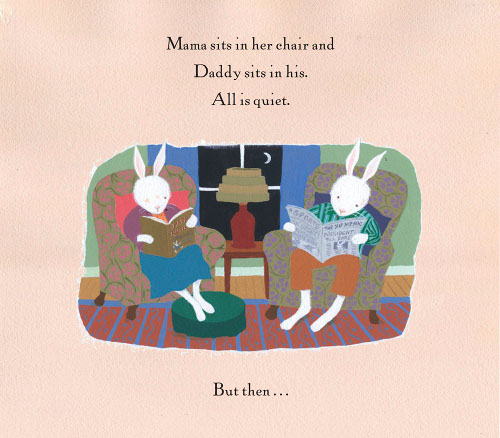



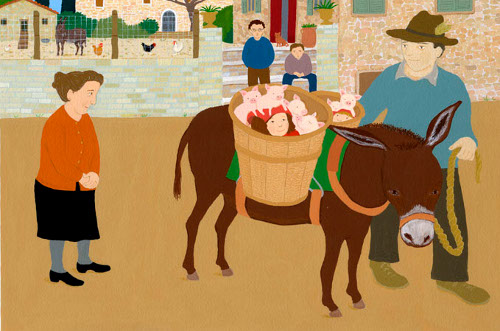
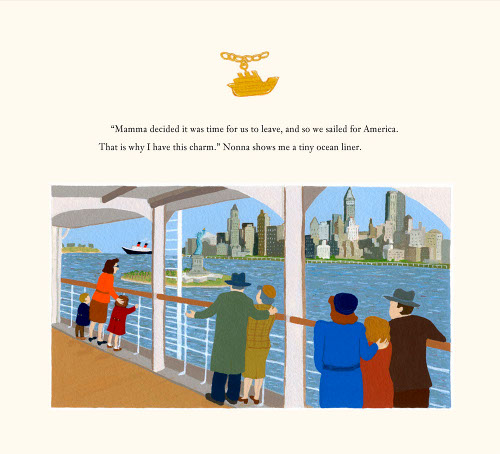

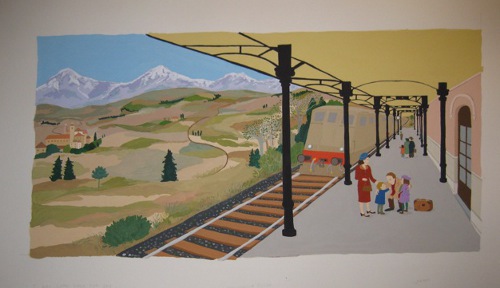
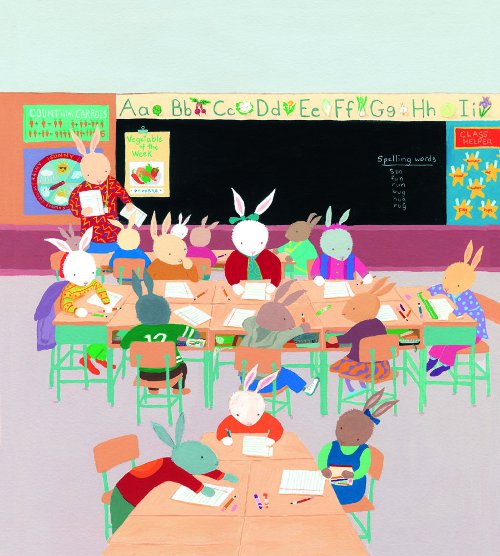


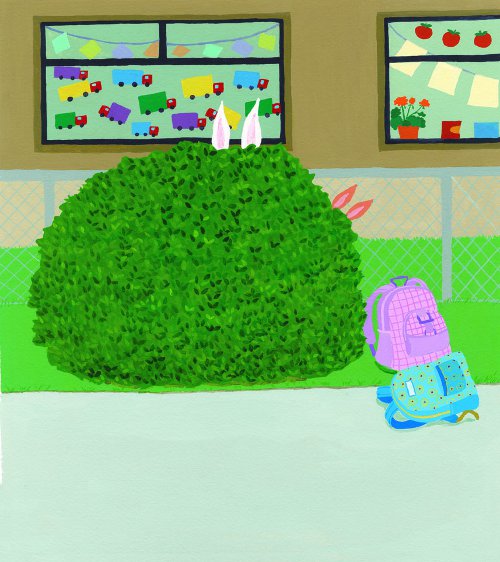

I’ve admired Ms. Russo’s work for a long time and loved hearing more about her here. Her paintings are so beautiful. Thanks for another fascinating and enlightening interview!
Jules and Marisabina: As thunder rumbles and much needed rain cascades down, how very wonderful it is to sit and read this interview. I have a new list of books to read and love. Thanks so much.
My favorite part is when Marisabina, an artist of such sensitivity and grace, cites the wonderfully ghastly imagery in “Slovenly Peter” as an influence. Amazing that there was such a time in children’s literature. Contrast like this makes children’s illustration so fascinating and irresistible. Best of luck with the graphic novel, Marisabina- I’ll be keeping an eye out for it.
wonderful to read and see (all those fabulous colors!!) this interview – how beautiful!
Thanks, Jules. I really enjoyed everything about this post. What a gracious and practical person, what beautiful illustrations. What a great new group of books to read! Can’t wait to add them to my list, just like Margie commented above.
[…] Before Breakfast book blog (more commonly known as 7-Imp among kidlit aficionados) posted “Seven Questions Over Breakfast with Marisabina Russo,” featuring art from her picture book Peter Is Just a […]
Enjoyed this immensely while waiting in jury duty.
[…] Marisabina Russo (July 25, 2012), pictured […]